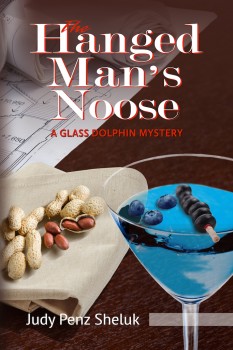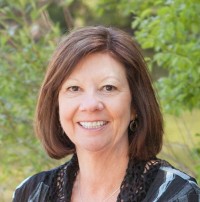The Hanged Man’s Noose by Judy Penz Sheluk
 By Dawn Ius
By Dawn Ius
Like that of many authors, Judy Penz Sheluk’s publishing journey was not without obstacles. Persistence paid off, though, and last July, THE HANGMAN’S NOOSE debuted with Barking Rain Press, making at least one of Sheluk’s publishing dreams come true.
Inspired in part by Sheluk’s varied careers, THE HANGMAN’S NOOSE tells the story of Emily Garland, a small town journalist whose research into a community issue puts her in the middle of a deadly investigation of murder and intrigue.
Sheluk took some time out this month to talk to The Big Thrill about her road to publication, THE HANGMAN’S NOOSE, and what readers can expect from her next.
You mention on your website that your journey to publication was long—please share a few highlights (or low lights) from that journey.
I finished THE HANGED MAN’S NOOSE in February 2013 and thought I needed an agent to get a publishing deal. I even had an agent who had expressed real interest at Bloody Words 2012 (a mystery conference in Toronto, Canada) and so I was convinced she would fall in love with the manuscript, sign me up, and sell it to one of the major publishing houses. That didn’t happen. I wrote about the experience quite candidly on my blog and The First Cut is the Deepest launched the My Publishing Journey series.
Beyond the obvious highlight—landing a publishing contract with Barking Rain Press—by far the most fun I’ve had is helping with the cover design for THE HANGED MAN’S NOOSE. I can’t speak for other publishers, but at BRP it’s a very collaborative process.
Now that you’re there—a published author!—is it everything you hoped it would be?
Well, I’m still waiting to make the New York Times bestseller list!
In all seriousness, it’s been an absolute blast so far. A dear friend offered to host a “Friends and Family Book Launch” in September and the support was truly overwhelming. I was invited to be the guest at a Toronto book club—the women, all in their mid-to-late thirties, had selected my book for their September read (thankfully they loved it). I attended the Debut Authors Breakfast and was on my very first panel at my very first Bouchercon in Raleigh. I’ve sold and signed books at a handful of Chapters locations in my region. I’ve been invited to read and speak at a nearby library. My local newspaper and our community magazine have both interviewed me. I can’t imagine it can get much better than this.
Of course, there is that niggling NYT bestseller thing…
Your blog is a great sounding board for new and established writers, and I get the sense your goal is to speak candidly about the publishing process. What do you hope readers take away from your posts?
Ideally, my blog offers other writers inspiration, advice and above all, hope. Writing is a lonely pursuit. There’s plenty of rejection. It’s important to know we aren’t alone. I also interview other authors to learn more about their work and their experiences so my readers are offered more than just my perspective.
What is the best writing advice you have ever received? Your worst? What advice would you give to new writers?
Author Greg Fallis was my instructor for Mystery II in the Fiction Writing certificate program at Gotham Writers Workshop. He critiqued a short story I had written and commented: “Remember, to your characters, this isn’t a story.” I’ve never forgotten that advice.
Worst? My own advice. “You can always write a book later.” It would be years before later came.
New writers: Join an association. In addition to ITW, I belong to Sisters in Crime (International/Toronto/Guppies), Crime Writers of Canada and the Short Mystery Fiction Society. Each of these organizations has offered me opportunities, information, resources, and most of all, the friendship and support of like-minded individuals. Membership really does have its privileges.
Like many novelists, you have a background in journalism and many of your articles have been published—how does your non-fiction writing help your fiction, if at all?
I’ve learned to write on deadline, to research effectively, and to take mundane facts and shape them into something that is, hopefully, interesting to read. The difference lies in the perspective. In non-fiction, we start with what has happened. In my fiction writing, I start with “What if this happened?”
Your freelance work is quite specialized—how does this complement your passions and interests? Background in antiques, perhaps?
I started freelance writing in 2003, after a long corporate career that included everything from Canadian Division Credit and Collections for a major insurance company—I was actually the youngest Division Credit Manager in the company’s history—to working with Regional/National Vice Presidents in a Sales and Marketing capacity for a manufacturer of high end office furniture. While I achieved a degree of success, I never quite fit into, or cared for, the corporate mould.
In May 2003, when my office furniture job was made redundant, I took my severance package and decided to use it to fund my start as a freelance writer. I gave myself a year to succeed. I’ve never looked back.
My first published article was about antique clocks—my husband, Mike, had a large collection at the time—for the now defunct Antiques Showcase. That led to other features in a variety of antiques publications, including New England Antiques Journal. I didn’t have a huge knowledge of antiques but I discovered an aptitude for research. I also discovered I was a good storyteller.
In 2007, NEAJ offered me the position of Senior Editor. The deal was I could work from home and set my own hours, just as long as the work got done. I’ve been with them ever since and love every minute of it. I’ve also learned a lot about antiques. I incorporate some of that knowledge in THE HANGED MAN’S NOOSE.
I’m also the Editor of Home BUILDER Magazine, a bi-monthly glossy billed as “the voice of the Canadian Home Builders Association.” I’ve been with HBM since about 2008, first as a writer, and in 2010, they offered me the editor’s gig with the same terms as NEAJ: work from home, set my own hours. I started writing for home building type publications early in my career, originally specializing in energy efficient building practices and home décor and design.
String enough writing jobs together as a freelancer and you can almost earn a living. Emphasis on the almost!
Emily Garland, the protagonist in THE HANGED MAN’S NOOSE, is a journalist—how much of her character is drawn from your experiences?
In the opening scene of THE HANGED MAN’S NOOSE, we find Emily reporting on Toronto’s red-hot condominium housing market. That part is culled from my experience as someone who has covered the residential construction industry. In the end of chapter one, Emily accepts a lucrative undercover assignment in the small town of Lount’s Landing. I’m still waiting for a lucrative assignment to come my way!
I love the premise for THE HANGED MAN’S NOOSE. What inspired this story? Without spoilers, tell us something about the book that you wouldn’t find on the Goodreads description.
THE HANGED MAN’S NOOSE originally started as a short story in a creative writing class led by Barry Dempster, an award winning poet and author. The story wasn’t particularly good, but I loved the town I created, and I couldn’t get Arabella Carpenter, the irascible owner of the Glass Dolphin antiques shop, out of my head. I thought, “what if a greedy real estate developer came to Arabella’s small, historic town with plans to build a mega-box store? What if there was a reporter sent to cover it? What if the reporter had her own hidden agenda?” I knew I had too many “what ifs” for a short story, so I decided to write a novel. That took about a year.
As far as something about the book, I’m reminded of the TV show House, where Dr. Gregory House famously says, “Everybody lies.” And they do. Well, maybe everyone but Arabella Carpenter. Her motto is “Authenticity Matters.” She can be a bit too authentic for her own good at times.
Your short stories have been published in a number of anthology collections. How does the process differ for you when writing these versus a full-length novel? Is one easier than the other for you?
I find short stories incredibly difficult to write. I’m a complete pantser at heart. That process works for novels because a novel allows time to develop characters, setting and plot. With short fiction, you really should know the beginning, middle and end before beginning.
Do you have any writerly quirks? Special tools of the trade? If we looked on your desk right now, what are three things that we might find, and what is the significance of each?
Not sure if it’s a quirk, but I write while listening to talk radio. Right now, the host on AM640 Toronto is talking about the increasing number of coyotes in urban and suburban areas. I get a lot of ideas from talk radio.
On my desk:
- A 4” x 6” framed mini poster. The image is a sailboat far off in the sunset, with the caption, “OPPORTUNITY: Don’t Wait For Your Ship To Come In . . . Swim Out To It.” It’s a philosophy I live by.
- A tube of The Body Shop’s cocoa butter lip balm. I have tubes of it everywhere. My purse, my bedside table, bathroom drawer. I’m always dabbing on cocoa butter lip balm.
- A brown file folder, filled with handwritten notes and ideas for my current work-in- progress.
What’s next for you? Will readers see more of Emily Garland?
I certainly hope so! I’m currently working on A HOLE IN ONE, which is the sequel to THE HANGED MAN’S NOOSE, and hope to have it ready to submit to Barking Rain Press by spring 2016. The plan is that Emily will be the sidekick, and Arabella Carpenter, the antiques shop owner, will take over as protagonist.
I recently completed another mystery novel, SKELETONS IN THE ATTIC, which is currently under consideration. With the exception of Arabella Carpenter, who makes a brief appearance, the characters and setting are new. It may or may not be a coincidence, but the protagonist in SKELETONS is addicted to cocoa butter lip balm!
*****
 Judy Penz Sheluk’s debut mystery, The Hanged Man’s Noose was published July 2015. Her short crime fiction is included in The Whole She-Bang 2 and World Enough and Crime.
Judy Penz Sheluk’s debut mystery, The Hanged Man’s Noose was published July 2015. Her short crime fiction is included in The Whole She-Bang 2 and World Enough and Crime.
In her less mysterious pursuits, Judy works as a freelance writer/editor. She is currently Editor of Home BUILDER Magazine and Senior Editor, New England Antiques Journal.
In addition to ITW, Judy is a member of Sisters in Crime (International, Guppies and Toronto) and Crime Writers of Canada.
To learn more about Judy, please visit her website.
- On the Cover: Alisa Lynn Valdés - March 31, 2023
- On the Cover: Melissa Cassera - March 31, 2023
- Behind the Scenes: From Book to Netflix - March 31, 2023
